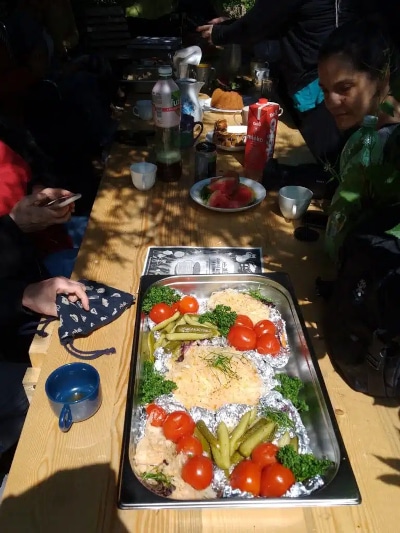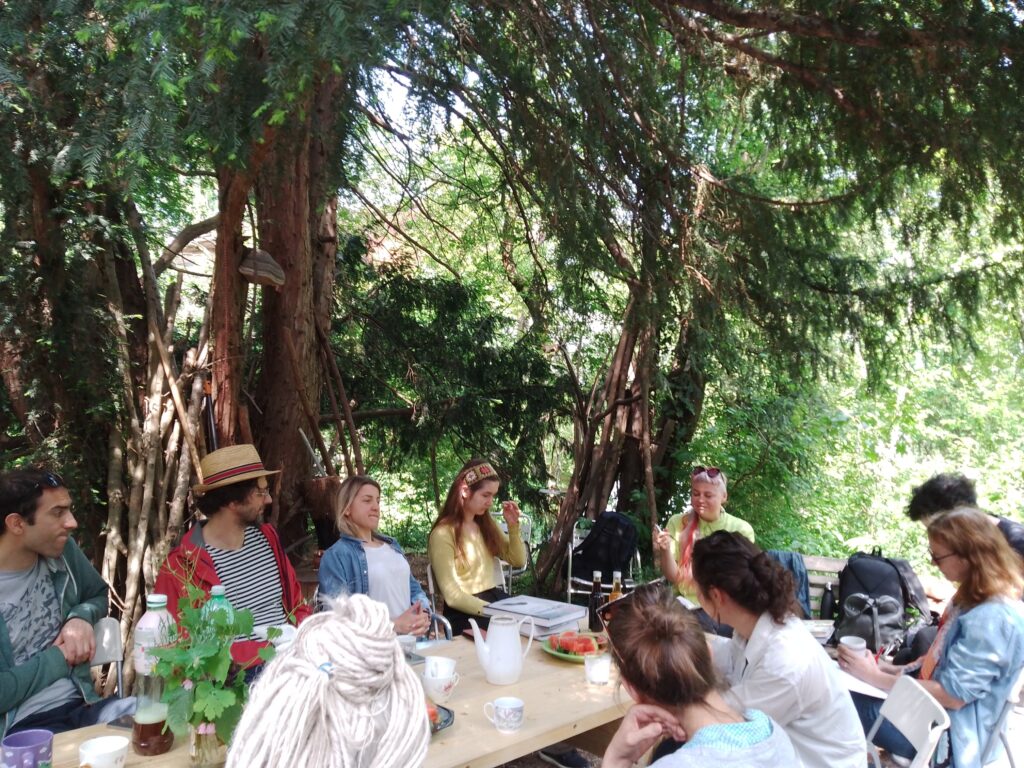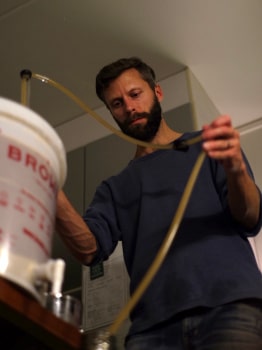By Lukáš Senft and Will LaFleur
Such diversity of participants! Anthropologists, artists, natural scientists, trees, compost, worms, pollen, aphids, and doubtless, countless others. In May, the Institute of Sociology of the Czech Academy of Sciences organised a CSSM-funded theory production workshop Co/sense and Re/create: Joint Inquiry into Gardening Microbiomes and Migrating Holobionts. Some participants were registered, while others were regular inhabitants of the garden and sculpture studio of Kafkárna, in Prague’s Dejvice district. One of the workshop meetings was dedicated to Ukrainian cuisine. Ukrainian cooks prepared dishes based on family recipes: borscht and various fermented and pickled foods.
The inclusion of food in social science analyses is not in itself new or innovative. Classical anthropological texts have long focused on the role of food and eating. For example, Edward Evans-Pritchard addressed the role attributed to cows by the Nuer of East Africa in his book The Nuer, and Mary Douglas analysed food taboos in her famous book Purity and Danger. The Encyclopedia of Social and Cultural Anthropology considers food a powerful instrument that can shape (and be shaped by) interpersonal interactions.
New approaches to studying eating as a socio-material activity have recently been offered by a research group led by Dutch anthropologist Annemarie Mol. In her new book Eating in Theory (2021), Mol builds on the works of Hannah Arendt, Maurice Merleau-Ponty, and Tim Ingold to conceptualise the materiality of the human body as embedded in non-human relationships, exploring how food transforms humans and how people, through practices related to food, transform the world. Everyday and seemingly banal acts of eating create connections between food, sensory capacities, political actions, agricultural practices, human and non-human histories, plants, and animals.
The following is a parallel reflection from two participants at the workshop, anthropologists Will LaFleur and Lukáš Senft, about the relationships, meanings, and processes of one food object encountered at the workshop, namely, fermented watermelon.
Lukáš
Saturday: the second day of the workshop. I’m waiting in the garden. I smell the scent of soil and the pleasantly bitter aroma of leaves. The air connects my body with the garden’s activities. Activated senses also amplify my hunger. I need something to eat. The workshop on Ukrainian cuisine will take place under the trees, around a long table. The event hasn’t started yet, but refreshments are already prepared on the board. Probably I could grab something small to eat before we taste Ukrainian dishes, I think to myself.

I sneak up to the table. Pieces of watermelon are lying on a deep plate. Bingo! But then I notice that there is water on the plate, and the watermelon is soaked in it. Probably to keep it from drying out, I say to myself. I’m not sure if I should take it, but hunger demands that I steal a piece. I take a slice that’s already cut. Water is dripping onto my hand and I quickly put the bite in my mouth. Then I grin. I’m hit by a salty and sharp taste. I stole spoiled food! This can’t be the taste of watermelon! That is my punishment for eating before I’m supposed to: the watermelon was probably left in the water for a long time, forgotten, and then it went bad. But I don’t have time for self-reflection; I should be helping with the organisation of the workshop.
The workshop begins. During the lecture, I learn that one of the dishes we can taste is fermented watermelon. At first, I don’t understand, but then it clicks. I’ve already tasted the fermented watermelon – that’s why the taste was so unusual! It wasn’t spoiled water but the traditional method of fermenting watermelon. The saltiness and sourness remain in my mouth, but something changes. The more I learn about the fermentation process of watermelon, the more I begin to appreciate its taste. Once the shock and suspicion of spoiled ingredients fade, I become fascinated by the combination of sourness and saltiness that continues to linger on in my mouth.
Will
It seemed to me that it was still too early in the season for watermelon, but slices of it were already stacked on a plate waiting for us. They looked delicious, but there was something slightly odd about them. They appeared to be a deeper red colour than I’m used to, and their texture looked strangely smooth, almost glossy, like they might lack the juicy, crisp sound watermelon makes when you bite into it. Upon closer inspection, these visual impressions deepened the intrigue, but the thought they may be fermented hadn’t yet crossed my mind. Our morning activity was a tasting of selected fermented foods prepared by Ukrainian cooks. The presentation included the fermented breadcrumb drink “kvass” and some different types of pickled vegetables, such as cucumbers and tomatoes. That’s when I learned the watermelon, too, was indeed fermented. I was surprised and thought this must be why it looked different. I’d never considered the possibility of fermented watermelon, but we learned it can be done simply by rubbing the slices with salt. Of course.
For me and several other participants, the taste of the watermelon was astonishing! I sunk my teeth into the flesh and was greeted by a rush of salty sourness that I’d never before associated with watermelon. The texture of the flesh, rather than crisp and light, felt more firm and full. I don’t recall exactly how many slices I ate, but it was at least four or five more throughout the day. I remember asking others what they thought of the watermelon. Some had struggled with the unusual, unexpected taste, seeming to have a hard time adapting to the surprising taste, while others were as enthusiastic as I was. “Oh my God… oh my God!!” exclaimed one of the participants with intense satisfaction in his eyes, shaking his head in joyous disbelief while we shared some laughter and more watermelon.
Lukáš
Annemarie Mol emphasises that during eating, the world moves through the body. So what happened to my body when it encountered the unfamiliar taste of fermented watermelon? What world did I metabolise? And what triggered the shock in my mouth? We ate watermelon prepared by Ukrainian cooks and European microorganisms. It was a product of knowledge brought by the cooks, their family skills passed down from generation to generation, and culinary practices that initiated the collaboration between food and microbes. All these relationships in a single bite!
However, it wasn’t the first time I tasted Ukrainian cuisine, fermented food, or the combination of imported ingredients and European culinary practices. The reason for my surprise was the difference between the familiar taste of watermelon and the taste of fermented watermelon. Later, I realised that the difference was enacted by the work of microorganisms: the new taste was the sensory embodiment of the invisible activity of microorganisms. The taste of watermelon materialised their effort for me, translating it into perceptible sensations. But first, I had to learn about the food to appreciate the microbial work. Once again, I invite Annemarie Mol into this discussion, as her insights capture my experience. Mol emphasises that knowledge of something increases the probability that we will like it: “Getting to know increases appreciation” (Mol, 2021b, 31:25). I appreciated the microbial work when I learned that it was the deliberate outcome of effort, not randomly created or even spoiled food.
Will
I’m inclined to think about the fermented watermelon in terms of the work that microbes do in relation to the intentions that lie beneath putting them to work. The process of microbial fermentation undoubtedly changed the look, taste, smell, and structure of the watermelon, that is, it did some kind of ‘work’, and this leads me to think about literature on microbes that discuss their action as ‘work’ and ‘labour’: Anna Krzywoszynska writes about “nonhuman labor” (2020) in relation to soil microorganisms, while Maan Barua writes about “metabolic work” in the context of large-scale animal husbandry (2019). Although both concepts seem suitable for thinking about fermentation as a process of metabolic changes or the commodification and marketing of fermentation processes, what about something as unique as a fermented watermelon? Most of us at the workshop had never encountered it, but the fact that it exists surely indicates some type of local specificity. It’s clear that there is a unique value in fermented watermelon and the metabolic fermentation process that gives the watermelon a specific taste and helps to create a specific experience. The question is whether we can consider this process as the ‘labour’ of microbes, as if the microbes were ‘employed’ to create primarily a specific taste sensation. In the fermented watermelon’s case, however, the fermentation was not done with the intention to accumulate capital, which is a stipulation for how Krzywoszynska uses the term “nonhuman labor”. In that sense, the term would appear to unduly anthropomorphise microbes by likening their work to, for example, the labor of an Amazon warehouse worker. I would consider that problematic and conceptually inconsistent. Clearly the microbes are doing some kind of ‘work’, but if the intention of fermentation in this case is bound up more with reproduction in the home rather than capitalist production for the market, the idea of ‘nonhuman labour’ doesn’t seem to fit here.

Lukáš and Will
Perhaps more stimulating is the fact that watermelon fermented in this way – given the not entirely controllable activity of microorganisms – would not likely easily be standardised and produced as a global commodity. In their manifesto for the democratisation of taste, Jan-Peter Voß and Michael Guggenheim (2019) stress that unusual ways of tasting are a political practice because they challenge collectively learned and enforced ways of relating to taste. To what political attachments, then, might the unusual taste of fermented watermelon refer? The metabolic fermentation process offers a wide range of flavours. One example of this process is alcoholic fermentation (for instance, the technique of mead production was independently developed on almost all continents), others are lacto-fermented vegetables or sourdough bread. Foods that have undergone fermentation processes can exhibit various degrees of acidity. Interestingly, the onset of industrial processes in food production largely aimed to eliminate acidity. This is true for beer production as well. Currently popular sour beers are in some ways a return to older production methods, and thus to a taste that was more common before the laboratory production of standardised yeasts and precision temperature control. The reduction of acidity is also evident in vegetable production. Since World War II, in the USA in particular, vinegar and sugar have increasingly been used instead of lacto-fermentation for pickling cucumbers, to the extent that ‘pickles’ are assumed to use vinegar (with a large dose of sugar) by default. The result is “sweet” pickles. The decline of acidity in foods and the rise of sweetness can be associated to some extent with the transition to capitalist accumulation, as Sydney Mintz showed in his classic text Sweetness and Power on the production, processing and consumption of sugar since the 16th century.
How can such a subtle and brief experience associated with tasting home-fermented watermelon contribute to social scientific analysis? Questioning how a food called watermelon is supposed to taste can lead to a necessary critical reflection on the social, economic, and political practices that create foods, as well as how their taste is standardised and thus established as the ‘right’ taste of that particular food. The sensory shock then points to how foods and their tastes are presented to us as obvious and unproblematic. Ultimately, such an experience can be an impulse to realise how many tastes and production methods are overlooked and outside the shared imagination of modern consumption.
Cover photo credit: Lukáš Senft
References
Barua, M. 2019. Animating capital: Work, commodities, circulation. Progress in Human Geography, 43(4), 650–669.
Krzywoszynska, A. 2020. Nonhuman Labor and the Making of Resources: Making Soils a Resource through Microbial Labor. Environmental Humanities 1, 12 (1): 227–249.
Mol, A. 2021a. Eating in Theory. Duke University Press.
Mol, A. 2021b. Eating in Theory: A Taster [Video]. Accessed August 30, 2023.
Voß, J., and Guggenheim, M. 2019. Making Taste Public: Industrialized Orders of Sensing and the Democratic Potential of Experimental Eating. Politics and Governance, 7(4): 224–236.




